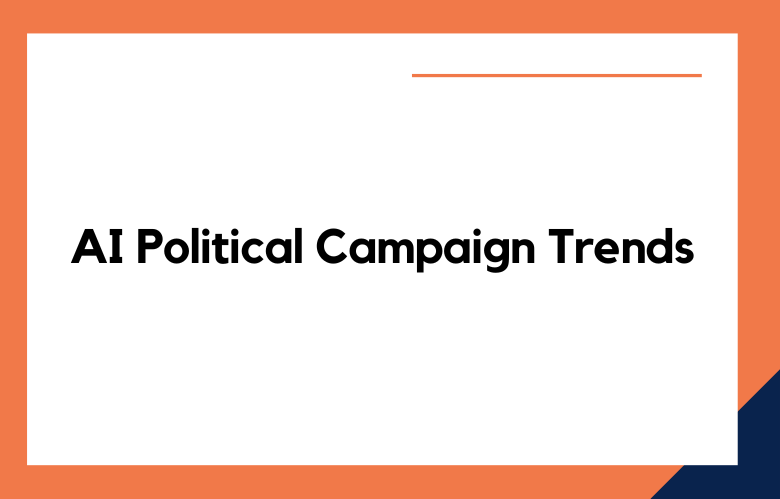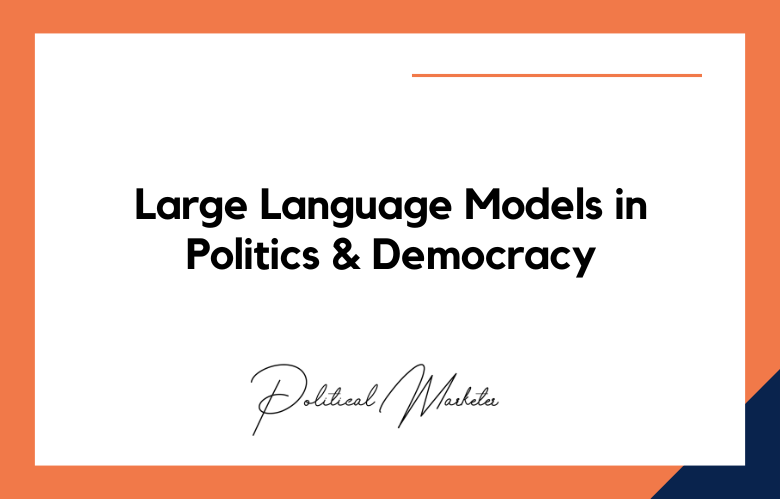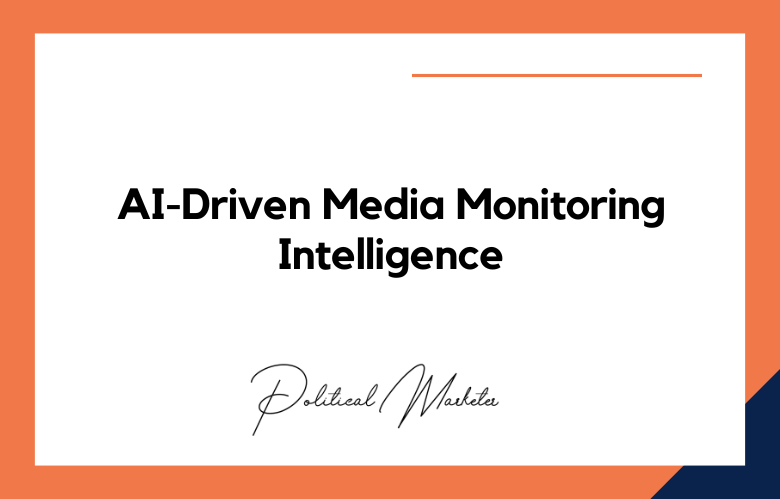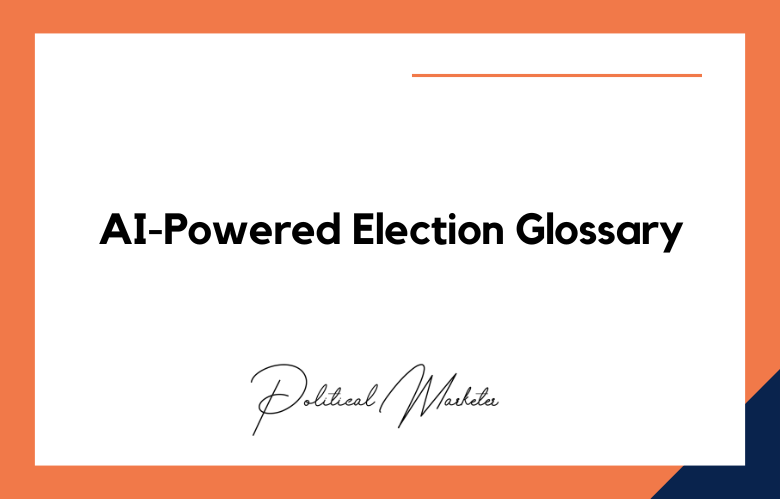Artificial intelligence (AI) is taking over the political space, and it’s only bound to increase in the coming years. This technology has already proven that it can claim the future of elections and campaigns.
It allows data-driven campaign strategies, precision targeting, and intelligent communication tactics to deliver better results. We will be discussing 100 AI political campaign trends worth watching in 2025.
Emphasis on data-driven targeting
Political campaigns will focus more on using data-driven targeting techniques to reach voters. This will include predictive analytics and machine learning algorithms.
Chatbots in campaign communication
Chatbots will be increasingly adopted in political campaign communications to efficiently engage with voters at scale.
Preference for personalized messages
Campaign messages will go beyond mass communication to offer customized notifications that appeal to individuals.
Increased adoption of facial analysis
Facial analysis technology will be used to gauge the emotional response of voters in real time during campaign rallies and debates.
Predictive analytics to avoid voter apathy
Predictive analytics will be used to identify and engage with voters who are at risk of becoming apathetic.
Adoption of personalized fundraising campaigns
Personalized fundraising campaigns will be designed using AI to help campaigns raise more money.
Strategies for combating disinformation
AI will be increasingly utilized to combat the spread of disinformation by identifying and flagging fake news stories.
Social media user-generated content.
Political campaigns will use AI to analyze and engage with user-generated content on social media platforms.
Creating awareness through digital footprints
Online records of individuals will be utilized to create awareness about the candidate’s campaign and convince them to vote.
Efficient targeting of millennials
Millennials will be targeted with campaigns based on their online behaviors and preferences.
Advanced speech recognition
Speech recognition techniques will be increasingly adopted to understand candidate speeches and potential voter stances better.
Use of social media influencers
Political campaigns will use AI to identify and engage with social media influencers to increase their reach and engagement.
Smart decision-making algorithm
Campaign managers will rely on AI to make more informed, data-driven decisions.
Use of natural language processing
Natural language processing will be used to understand, process, and analyze large quantities of campaign data.
Building brand loyalty through AI-driven content
AI will be used to create personalized content to appeal to the emotions and values of voters.
Automated AI chatbots to speed up campaign communication
Political campaigns will use automated AI chatbots to speed up contact with voters.
Real-time sentiment analysis using chatbots
Chatbots will analyze voter sentiment in real-time to help candidates tailor their messages effectively.
Use of social listening to engage voters
Campaigns will increasingly analyze social conversations to engage with potential voters.
Targeted micro-influencers
Campaigns will use micro-influencers to engage with potential voters, building trust and loyalty.
Personalized campaign ads
Campaign ads will be personalized, making them more targeted, relevant, and engaging to the individual voter.
Bright recruitment for volunteers
Campaign campaign volunteers will be recruited using intelligent recruitment algorithms targeting suitable candidates.
Sophisticated voter segmentation
Advanced voter segmentation will help campaigns reach voters with the right messages.
AI-backed data visualization
AI will power data visualization and reporting for better decision-making.
Blockchain technology
Blockchain technology will be used to eliminate fraud and increase transparency in elections.
Use of predictive models for voter behavior
Predictive models will be used to analyze voter behavior and predict future voting patterns.
AI-powered automated canvassing
Campaigns will automate their canvassing efforts using AI tools.
Social listening to understand voter values
Social listening techniques will be used to analyze conversations and better understand voter values.
Intelligent targeting of undecided voters
Campaigns will use AI-driven targeting techniques to engage with undecided voters.
Personalized automation through chatbots
Chatbots will offer personalized automation to engage voters and encourage donations.
Brilliant insights with intelligent data gathering
AI will be used to gather thoughtful insights through various communication channels.
AI-driven influencer identification
AI will be used to identify key influencers who can help campaigns reach out to potential voters.
Personalized email campaigns
Emails will be personalized to aid the campaigns’ outreach efforts.
Predictive analysis of public opinion
Predictive analysis of public opinion will be used to understand elections’ pulse better.
Gamification of outreach
Campaigns will use game design concepts to engage voters and increase interaction.
AI-powered polling
Campaigns will conduct AI-powered polling to gather data and improve accuracy.
Social media sentiment analysis
Social media sentiment analysis will be used to gauge the electorate’s mood.
Precision targeting
Targeting strategies will be used in an accurate and granular manner to reach voters who are more likely to support the candidate.
Personalized chatbot scripts
Campaigns will utilize personalized chatbot scripts based on voter preferences.
Personalized video content
Customized video content will influence voters’ opinions and persuade them to vote.
AI-backed lead generation
AI will be used to streamline lead generation, thereby increasing conversion rates.
Advanced data analytics
Advanced data analytics will analyze voter behavior and strengthen campaign strategies.
AI-driven fundraising
AI will be used to optimize fundraising efforts, thereby increasing donations’ amount.
Improved offer designs
Advanced algorithms will be used to design better offers, making them more appealing to voters.
Automating predictive modeling
Predictive modeling will be automated, reducing campaign managers’ workload.
Streamlining market segmentation
Campaign managers will use AI to segment their markets more quickly and efficiently.
Personalized ad content
Ads will be customized to suit the voter’s preferences, maximizing the likelihood of a conversion.
Advanced audience analysis
Audience analysis techniques will become more advanced, allowing campaigns to gather more granular insights.
Machine learning in social media
Machine learning algorithms will be used to analyze data and trends in social media.
Creative segmentation strategies
Campaign managers will devise new creative segmentation strategies to target specific groups of voters.
Predictive modeling in canvassing
Predictive modeling will be used to identify campaign messaging that resonates with voters.
Integrated campaign reporting
Campaign reporting will be integrated, giving campaign managers a better view of their efforts.
Micro-campaigns using AI-based segmentation
AI-based segmentation will be used to devise micro-campaigns and reach out to specific voter groups.
Smarter lead nurturing
AI will be used to nurture leads more effectively, increasing the likelihood of conversions.
Dynamic ad creation
Ads will be created dynamically according to user preferences and browsing behavior.
Strategic use of intuition
Campaign managers will use intuition with AI to gain a deeper understanding of voter behavior.
Chatbot analytics
Chatbot usage analytics will help campaigns fine-tune their chatbot strategy and offer a more personalized experience.
Social media outreach
Campaigns will use social media more proactively to reach out to potential voters.
Influencing voter behavior with personalized ads
Personalized ads will be used to influence voter behavior in a more targeted and efficient manner.
Data-driven storytelling
Campaigns will use data to craft more impactful stories that resonate with voters.
Focusing on mobile users
Campaigns will emphasize targeting voters who use mobile devices to access the internet.
Advanced data mining
Campaigns will use cutting-edge data mining techniques to gain deeper insights into voter behavior.
Building user personas with AI
AI will be used to create user personas that help campaigns better understand their voter base.
Smart level-setting for analytics
Campaign managers will use AI to level-set their analytics, improving their results’ accuracy.
Campaign simulations
Campaigners will run simulations to identify the best strategies before deploying any campaign tactics.
Using AI in competition analysis
AI will identify strengths and weaknesses in the opponent’s campaign.
Automated bid management
AI will be used to optimize campaign bids, thereby maximizing return on investment.
Smart quality scoring
Campaign managers will use AI to score the quality of their leads and improve the accuracy of their targeting.
Crowdsourcing campaign ideas
AI will be used to crowdsource campaign ideas that resonate with voters.
Use of augmented reality
Augmented reality will be used to create engaging interactions with voters.
Personalized chatbot experiences
Chatbots will be personalized to suit the user’s preferences, increasing conversion rates.
Campaign micro-influencers
Campaigns will focus on micro-influencers who can influence a smaller, more engaged group of voters.
Advanced natural language processing
Advanced natural language processing algorithms will enable campaigns to understand voter sentiment more accurately.
Predictive modeling for telephone canvassing
Predictive modeling will be used to optimize telephone canvassing, reducing campaign costs.
Leading with empathy
AI will help campaign managers lead with empathy and connect with voters more deeply.
Building out the chatbot ecosystem
Multiple chatbots will operate within an ecosystem to provide voters with a more efficient and seamless experience.
Real-time chatbot reporting
Chatbot usage reports will be provided in real-time, allowing for quick adjustments and better engagement.
Precision demographics
Precision targeting of demographics will be used to reach the right individuals with the right messages.
Smart polling
AI has made it possible to conduct more accurate and cost-effective polls than traditional methods. Smart polling uses algorithms to analyze voter data and identify critical issues that resonate with voters.
Predictive analytics
AI-powered predictive analytics tools can analyze large amounts of voter data, allowing campaigns to identify potential supporters and tailor their messaging accordingly.
Social media monitoring
With over 3 billion people using social media, AI-powered tools can help political campaigns monitor social media in real-time for relevant issues and conversations. This information can help movements adjust their messaging and strategy.
Personalized ads
AI-powered ad targeting allows political campaigns to display ads to individual voters based on their interests, demographics, and voting history.
Speech recognition
AI-powered speech recognition tools can transcribe speeches, debates, and interviews, allowing campaigns to create accurate transcripts and identify key messaging points.
Chatbots
Political campaigns can use chatbots to engage with voters online and answer their questions in real-time. Chatbots can also be used to facilitate donations and volunteering.
Cybersecurity
As political campaigns become increasingly digitized, the risk of cybersecurity threats increases. AI-powered cybersecurity tools can help campaigns identify and respond to potential threats.
Natural language processing
AI-powered natural language processing tools can analyze voter sentiment in real time. This information can help campaigns understand voters’ feelings about different issues and adjust their messaging accordingly.
Microtargeting
AI-powered microtargeting allows political campaigns to identify and engage with small groups of voters who share similar interests and values.
Voice assistants
Political campaigns can use AI-powered voice assistants like Amazon’s Alexa or Google’s Assistant to engage with voters more conversationally.
Image recognition
AI-powered image recognition tools can identify logos and slogans on campaign signs and billboards. This information can help campaigns understand which messages are resonating with voters.
Sentiment analysis
AI-powered sentiment analysis tools can analyze social media posts and news articles to determine voters’ feelings about candidates and issues.
Machine learning
Machine learning algorithms can analyze voter data and identify patterns that may be useful in predicting election outcomes.
Video analysis
AI-powered video analysis tools can be used to analyze political ads and speeches to identify key messaging points and potential vulnerabilities.
Influencer marketing
Political campaigns can use AI-powered influencer marketing tools to identify social media influencers who can help spread their message to a broader audience.
Robo-calling
AI-powered robocalling tools can make automated phone calls to voters, delivering targeted messages based on their voting history and interests.
Chat analysis
AI-powered chat analysis tools can analyze online chat conversations to determine voters’ feelings about candidates and issues.
Gamification
Political campaigns can use gamification to engage voters and make the political process more fun. This can include quizzes, games, and other interactive experiences.
Natural language generation
AI-powered natural language generation tools can create personalized messages for individual voters based on their interests and voting history.
Augmented reality
Political campaigns can use augmented reality to create immersive experiences that help voters understand complex issues and policies.
Virtual reality
Political campaigns can use virtual reality to create virtual campaign rallies and events, allowing voters to feel like they’re there in person.
Data visualization
AI-powered data visualization tools can create interactive visualizations of voter data, allowing campaigns to understand better how different groups of voters feel about other issues.
Algorithmic decision-making
AI-powered algorithmic decision-making tools can make complex decisions based on large amounts of data.
Data analysis
AI-powered data analysis tools can analyze large amounts of voter data, identifying patterns and trends that can inform campaign strategy.
Conclusion
Artificial intelligence is undoubtedly a game-changer in the political campaign industry. In 2025, campaigns are expected to leverage AI to improve their campaign optimization and results.
From AI-generated campaign content to chatbots and sentiment analysis, we must keep our eyes open to all sorts of AI-driven trends in political campaigns. The future belongs to those who embrace this budding technology. So, it’s time to start exploring AI for better political campaigns.
Call: +91 9848321284
Email: [email protected]
100 AI Political Campaign Trends Worth Watching in 2025: FAQs
What Role Do Automated AI Chatbots Play in Political Campaigns?
They enable real-time contact with voters by answering queries, providing information, and facilitating engagement 24/7.
How Is Real-Time Sentiment Analysis Used in Campaign Strategy?
AI-driven sentiment analysis monitors public reactions to messaging and events, helping campaigns adjust communications promptly.
Can AI Personalize Fundraising Campaigns Effectively?
Yes. AI helps tailor fundraising appeals based on individual donor profiles, boosting conversion through personalization.
How Does AI Combat Disinformation During Elections?
By identifying and flagging fake news or deepfake content, AI tools help campaigns and platforms limit misinformation.
In What Ways Do Campaigns Use Social Media User‑Generated Content?
AI analyzes public posts and comments to inform content strategy and engage supporters on relevant issues.
How Are Social Media Influencers Identified by AI?
AI scans metrics, audience alignment, and engagement to pinpoint influencers who resonate with voter segments.
What Are Smart Decision-Making Algorithms in Campaign Management?
They use AI to process data and offer recommendations on strategy, resource allocation, and messaging priorities.
How Is Natural Language Processing (NLP) Applied in Campaigns?
NLP enables efficient analysis of large volumes of text such as debates, speeches, and social media, extracting key trends and sentiments.
How Does AI Build Brand Loyalty Through Content?
By tailoring content that aligns with voters’ emotions and values, AI strengthens engagement and loyalty.
What Is AI-Powered Volunteer Recruitment?
AI identifies and targets individuals likely to volunteer, helping campaigns build more effective grassroots teams.
How Does Sophisticated Voter Segmentation Work with AI?
Data-driven AI divides voters into micro-segments for highly customized messaging and outreach strategies.
In What Ways Does AI Support Data Visualization for Campaigns?
AI tools create dynamic visuals and interactive dashboards, simplifying complex data for decision-makers.
How Is Blockchain Mentioned in the Context of Campaign Transparency?
Blockchain can enhance transparency in campaign financing and voter data security, though it remains experimental.
Can AI-Powered Models Predict Voter Behavior Accurately?
Yes. Predictive models based on historical and real-time data can forecast voting patterns and identify persuasion targets.
What Are the Benefits of AI-Automated Canvassing?
AI schedules and guides canvassing efforts by targeting regions and households most likely to respond positively.
How Is Micro-Influencer Targeting Optimized with AI?
AI spots small-scale influencers whose audiences closely match campaign messaging goals, amplifying niche reach.
How Do Personalized Chatbot Scripts Work in Campaigns?
They adapt conversation flow and tone based on individual voter profiles for more relatable engagement.
What Is Gamification of Outreach in Political Campaigns?
Campaigns use game elements like quizzes and reward systems powered by AI to boost engagement and participation.
What Does “Smart Polling” Mean for Campaign Strategy?
AI-driven polls dynamically adjust sampling and questioning to improve accuracy and relevance in near real time.
How Are Voice Assistants Used in Political Engagement?
AI voice services like smart speakers enable conversational access to candidate info, events, and calls to action.











